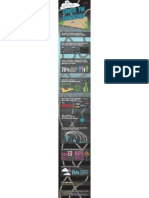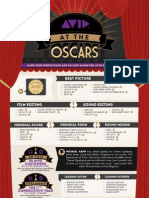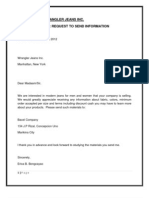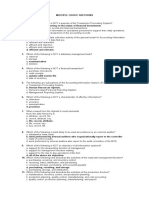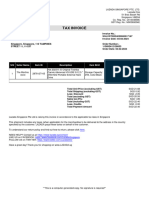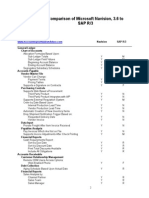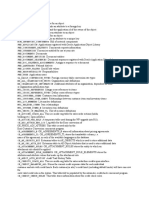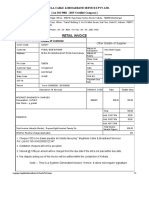Professional Documents
Culture Documents
MOLA 2014: Comparing MakeMusic Finale and Avid Sibelius
Uploaded by
Avid0 ratings0% found this document useful (0 votes)
12K views6 pagesAt the 2014 annual conference of the Major Orchestra Librarians’ Association (MOLA) held in Miami Beach, Florida, May 2nd to 5th, Philip Rothman of NYC Music Services presented a comparison between Sibelius and Finale music notation applications. Of the 30 features covered, Sibelius came out on top with 15 ticks, 6 were tied and Finale had 9 ticks. Check out the PDF link for full details.
Copyright
© © All Rights Reserved
Available Formats
PDF, TXT or read online from Scribd
Share this document
Did you find this document useful?
Is this content inappropriate?
Report this DocumentAt the 2014 annual conference of the Major Orchestra Librarians’ Association (MOLA) held in Miami Beach, Florida, May 2nd to 5th, Philip Rothman of NYC Music Services presented a comparison between Sibelius and Finale music notation applications. Of the 30 features covered, Sibelius came out on top with 15 ticks, 6 were tied and Finale had 9 ticks. Check out the PDF link for full details.
Copyright:
© All Rights Reserved
Available Formats
Download as PDF, TXT or read online from Scribd
0 ratings0% found this document useful (0 votes)
12K views6 pagesMOLA 2014: Comparing MakeMusic Finale and Avid Sibelius
Uploaded by
AvidAt the 2014 annual conference of the Major Orchestra Librarians’ Association (MOLA) held in Miami Beach, Florida, May 2nd to 5th, Philip Rothman of NYC Music Services presented a comparison between Sibelius and Finale music notation applications. Of the 30 features covered, Sibelius came out on top with 15 ticks, 6 were tied and Finale had 9 ticks. Check out the PDF link for full details.
Copyright:
© All Rights Reserved
Available Formats
Download as PDF, TXT or read online from Scribd
You are on page 1of 6
MOLA 2014
Finale and Sibelius:
A Comparison
Page 1 of 6
www.philiprothman.com www.nycmusicservices.com
NYC Music Services
www. nycmusi cservi ces. com
Philip Rothman, music preparer
BILL TO SHIP TO
Address
Address
P.O. NO. TERMS SHIP DATE SHIP VIA JOB NUMBER
1/1/2011 Due upon receipt 1/1/2011 electronic n/a
QUANTITY DESCRIPTION RATE AMOUNT
1.00
Project
0.00
0.00
Subject to 1.5% late fee ($15 minimum) per month after 30 days
Please make check payable to Philip Rothman Music & Consulting
Thank you!
Total
$0.00
INVOICE
DATE INVOICE #
1/1/2011 110101-01
Item Advantage:
Finale
Advantage:
Sibelius
Comments
Setup and basics
Score setup tossup tossup Both programs have setup wizards that offer ready-made templates as well
as options for customization.
Selecting and working with
objects
!
There are no tools in Sibelius, so you can select a note, an expression and
a line and, say, delete them all at once. It is not possible to select more
than one object at a time in Finales Selection Tool; to do that, you must
use a particular tool. Once there you can only work with the items specific
to that tool. It is also possible to select non-contiguous staves in Sibelius;
this is not possible in Finale.
Program defaults
!
Sibelius gets better results more quickly. Magnetic Layout, while not
perfect, makes aligning items and avoiding collisions much easier. Placing
articulations in the correct position, especially when using multiple
articulations, is much easier in Sibelius. Sibelius has better beaming
defaults. Sibelius will automatically vertically justify staves on a page.
Advanced customization
!
Many things can be customized in Finale in ways that they sometimes
cannot in Sibelius. Noteheads, notes, pages, staves, systems, and many
other items can be resized individually with limitless options in Finale.
Note entry, key signatures,
time signatures, clefs and
barlines
tossup tossup Both programs are similar when it comes to the basics of entering notes
via a computer or MIDI keyboard, or a mouse. Entering time and key
signatures, clefs, and barlines is comparable but different in each program.
Transposing scores
!
Finale 2014 narrowed the gap; prior to this version it was not possible to
create a true atonal, or keyless key in Finale. Still, Sibelius has a slight
edge when it comes to correctly dealing with C instruments that transpose
at the octave like xylophone, piccolo and contrabass. These instruments
customarily show at transposed pitch even in C scores; only Sibelius
handles this correctly. Sibelius also gives correct aural feedback when
entering notes into a transposed score via a MIDI keyboard; Finale will play
the actual pitch entered on your keyboard instead of the transposed pitch
of the instrument.
MOLA 2014
Finale and Sibelius:
A Comparison
Page 2 of 6
www.philiprothman.com www.nycmusicservices.com
NYC Music Services
www. nycmusi cservi ces. com
Philip Rothman, music preparer
BILL TO SHIP TO
Address
Address
P.O. NO. TERMS SHIP DATE SHIP VIA JOB NUMBER
1/1/2011 Due upon receipt 1/1/2011 electronic n/a
QUANTITY DESCRIPTION RATE AMOUNT
1.00
Project
0.00
0.00
Subject to 1.5% late fee ($15 minimum) per month after 30 days
Please make check payable to Philip Rothman Music & Consulting
Thank you!
Total
$0.00
INVOICE
DATE INVOICE #
1/1/2011 110101-01
Item Advantage:
Finale
Advantage:
Sibelius
Comments
Notes and notations
Cautionary accidentals
!
Sibelius has various options to automatically display cautionary
accidentals. In Finale, this is done via a plug-in that must be run again if
the document changes.
Glissando lines
!
In Finale it is easy to create any type of line and have it automatically snap
to two notes, even if the notes are on different staves, something that it not
possible in Sibelius.
System lines
!
Global lines like rit. poco a poco _ _ _ that automatically display in parts
are only possible in Sibelius, although both programs can handle global
text without a problem.
Tremolos
!
Tremolos of both the single note and multi-note variety are supported
better in Sibelius. Sibelius will automatically adjust the stem length on
notes with tremolos, if needed. Tremolos between two notes are also
natively supported in Sibelius and can be easily enabled or disabled; in
Finale, a plug-in is necessary.
Beams and stems tossup tossup Each program has strengths. Sibelius has better default beam algorithms,
easy beaming over barlines, and ways to quickly adjust the most common
beam variations. Finale will automatically float rests under a beam, and
allows you to individually adjust all the properties of a beam or any
secondary beam.
Brackets and staff groups
!
Sibelius is very limiting in how instruments can be grouped in the score.
Finale offers nearly unlimited possibilities with support for nested groups;
individual control on a system-by-system basis; more brace and bracket
styles; fine control on bracket positioning; and a brace designer.
Nonstandard key signatures
!
Finale allows you to build key signatures like those found in maqam or
other folk-derived scales, which are not possible in Sibelius.
MOLA 2014
Finale and Sibelius:
A Comparison
Page 3 of 6
www.philiprothman.com www.nycmusicservices.com
NYC Music Services
www. nycmusi cservi ces. com
Philip Rothman, music preparer
BILL TO SHIP TO
Address
Address
P.O. NO. TERMS SHIP DATE SHIP VIA JOB NUMBER
1/1/2011 Due upon receipt 1/1/2011 electronic n/a
QUANTITY DESCRIPTION RATE AMOUNT
1.00
Project
0.00
0.00
Subject to 1.5% late fee ($15 minimum) per month after 30 days
Please make check payable to Philip Rothman Music & Consulting
Thank you!
Total
$0.00
INVOICE
DATE INVOICE #
1/1/2011 110101-01
Item Advantage:
Finale
Advantage:
Sibelius
Comments
Text
Text in the music
!
The new features Sibelius 7 put Sibelius ahead of Finale. Advanced
typography options like wrapped text in expressions, angled text, and the
ability to create parent and child text styles are Sibelius-only features.
Sibelius offers point increments of .5 pt, compared to 1 pt in Finale, and
also allows for different settings in the score and the partall features
lacking in Finale. Finale does offer more enclosure options, although not at
the text style level. Both programs offer a house style or category
system of text management, where default styles and positioning can be
set.
Text on the page
!
Simply dropping text on the page independent of the music is virtually
impossible in Sibelius, unless its a blank page. Specifying a finite page
rage for a header or footer is equally impossible, but in Finale, its very
easy to do. (Its so easy, in fact, that novices often place text blocks where
they should be placing expressions, and run into other sorts of trouble.)
Both programs do allow extensive use of wildcards to automatically insert
score metadata in text areas.
Bar numbers
!
For most typical cases, the programs perform equally well and have
options to add prefixes and suffixes, skip bars, and change from numbers
to letters within a document. But Finales measure numbering options are
far more customizable when it comes to complex situations, as well as
allowing varying styles within the same document or even the same
section of music.
Page numbers tossup tossup Finales concept is much more straightforward, but also more limiting.
While both programs allow for different page numbers than the actual page
(page offsets), only Sibelius allows for different settings for the score and
each part. In Finale, this has to be accomplished via separate text blocks
for each part that are then hidden in all the other parts. Both programs can
calculate the total number of pages in a score.
MOLA 2014
Finale and Sibelius:
A Comparison
Page 4 of 6
www.philiprothman.com www.nycmusicservices.com
NYC Music Services
www. nycmusi cservi ces. com
Philip Rothman, music preparer
BILL TO SHIP TO
Address
Address
P.O. NO. TERMS SHIP DATE SHIP VIA JOB NUMBER
1/1/2011 Due upon receipt 1/1/2011 electronic n/a
QUANTITY DESCRIPTION RATE AMOUNT
1.00
Project
0.00
0.00
Subject to 1.5% late fee ($15 minimum) per month after 30 days
Please make check payable to Philip Rothman Music & Consulting
Thank you!
Total
$0.00
INVOICE
DATE INVOICE #
1/1/2011 110101-01
Item Advantage:
Finale
Advantage:
Sibelius
Comments
Lyrics and vocal music
!
For simple scores, both programs are fine. For large scores, a lot of lyrics
can slow Finale to a crawl. Unscrambling a Finale file where the composer
has indiscriminately applied lyrics in different verses or sections is not for
the faint of heart. There is also a rare but serious bug where Finale will re-
assign lyric syllables throughout the score. Sibelius can automatically apply
elisions in lyrics; Finale cant. Sibelius also can identify vocal staves and
automatically position text, hairpins, and tuplets above the staff on these
staves.
Chord symbols
!
Both programs are comparable in the features offered. Sibelius recognizes
chords better, can easily provide equivalent chord text and in general is
easier to work with.
Layout
Independent page, staff and
system sizes
!
Finale has a clear advantage here. Staff, system and page sizes and
settings can all be adjusted on an individual basis in Finale. In Sibelius, it is
possible to set sections with different page margins and to have a small
staff at a fixed percentage size, but the options are nowhere near as varied
as what is offered in Finale.
Page layout tossup tossup Both programs offer sophisticated page layout options, but go about it in
different ways.
Multiple movements
!
Even though Finale can place page text better than Sibelius, there is no
way in Finale to automatically center a text block on a page and attach it to
a particular system. This is possible in Sibelius and thus makes placing
section or movement subtitles much easier. In Sibelius, if an instrument is
tacet in a section between two final barlines, the part will automatically
have one giant TACET multirest for those measures. Both programs can
automatically place full instrument names in the score at the start of a
section.
MOLA 2014
Finale and Sibelius:
A Comparison
Page 5 of 6
www.philiprothman.com www.nycmusicservices.com
NYC Music Services
www. nycmusi cservi ces. com
Philip Rothman, music preparer
BILL TO SHIP TO
Address
Address
P.O. NO. TERMS SHIP DATE SHIP VIA JOB NUMBER
1/1/2011 Due upon receipt 1/1/2011 electronic n/a
QUANTITY DESCRIPTION RATE AMOUNT
1.00
Project
0.00
0.00
Subject to 1.5% late fee ($15 minimum) per month after 30 days
Please make check payable to Philip Rothman Music & Consulting
Thank you!
Total
$0.00
INVOICE
DATE INVOICE #
1/1/2011 110101-01
Item Advantage:
Finale
Advantage:
Sibelius
Comments
Parts
Parts tossup tossup Each programs offer advantages over the other:
Finale is the only program to feature voiced linked parts; in other words,
parts that automatically split a score staff with two musical lines into
independent parts. It mostly works, but there are a few glitches, like with
grace note spacing.
Only Finale can respell a note enharmonically in the part while keeping the
original in the score; useful for concert pitch scores.
Finale has more sophisticated options for independent settings for time
signatures in the score versus the part.
Sibelius allows independent text sizes for the score and parts; Finale
doesnt.
Copying the layout from one part to another is built into Sibelius; in Finale
a plug-in must be used.
Multirests
!
Finale has an edgewith caveats. Multirest settings can be controlled on
an individual basis, and you can break multirests in one part of your
document and display them elsewhere. The caveats: Its easier for
multirests to go awry in Finale if they arent set to update automatically;
Sibelius will automatically make space in a multirest with a clef change (in
Finale this must be done manually); Sibelius will automatically size
multirests proportionally (in Finale this must be done with a plug-in).
Cues
!
The Paste as Cue option in Sibelius is superior to the Finale plug-in Add
Cue Notes. The Sibelius option can hide the music in the score, show it in
the part, reduce the size, add a default rest and mute playback all in one
go. In Finale these steps are separate and found in different areas of the
program.
MOLA 2014
Finale and Sibelius:
A Comparison
Page 6 of 6
www.philiprothman.com www.nycmusicservices.com
NYC Music Services
www. nycmusi cservi ces. com
Philip Rothman, music preparer
BILL TO SHIP TO
Address
Address
P.O. NO. TERMS SHIP DATE SHIP VIA JOB NUMBER
1/1/2011 Due upon receipt 1/1/2011 electronic n/a
QUANTITY DESCRIPTION RATE AMOUNT
1.00
Project
0.00
0.00
Subject to 1.5% late fee ($15 minimum) per month after 30 days
Please make check payable to Philip Rothman Music & Consulting
Thank you!
Total
$0.00
INVOICE
DATE INVOICE #
1/1/2011 110101-01
Item Advantage:
Finale
Advantage:
Sibelius
Comments
Other features
Playback
!
Sibelius 7.5 offered enhancements to playback that addressed certain
deficiencies that otherwise would have made this category a tossup.
Quickly initiating playback is a little easier in Sibelius; you can select a staff
or staves to solo them without having to use the Mixer, like in Finale.
Sibelius does a better job of interpreting a wide variety of staff and system
text, including advanced navigation like endings, repeats, codas, and even
a custom playback structure. Both programs support third-party libraries,
but the Sibelius sound set ecosystem is better.
Video
!
Both programs support video sync and offer various frame rate and
playback options. Sibelius has a hit point feature and supports ReWire
syncing with DAWs and sequencers, which Finale does not.
Backwards compatibility
!
The edge to Sibelius, but only for the moment. It is possible to export
Sibelius files all the way back to version 2. Finale 2014 can only export
back to Finale 2012 format (and to MusicXML). Finale 2014 and future
versions of Finale will be written in a future-proof way such that exporting
should not be necessary, though this remains to be seen in practice.
Plug-ins and extendibility tossup tossup Both programs have a small number of active developers that create useful
plug-ins for the program. In Sibelius 7, you can download plug-ins directly
from within the program. Finale doesnt offer this, but it does have a more
user-friendly way to write macros.
Sharing and MusicXML
!
Sibelius 7.5 gained some features that allows for automatic sharing of
video and audio to YouTube, Facebook and SoundCloud. Both programs
can export audio of the score, MIDI, and PDF. Both programs can import
from and export to the MusicXML format, although expect Finale to be
more tightly integrated with this format, since MakeMusic controls it.
Support
!
MakeMusic offers unlimited complimentary phone support; Avid offers only
90 days. Both companies have official reps on social media and forums.
You might also like
- The Subtle Art of Not Giving a F*ck: A Counterintuitive Approach to Living a Good LifeFrom EverandThe Subtle Art of Not Giving a F*ck: A Counterintuitive Approach to Living a Good LifeRating: 4 out of 5 stars4/5 (5794)
- Media On The MindDocument1 pageMedia On The MindAvidNo ratings yet
- The Little Book of Hygge: Danish Secrets to Happy LivingFrom EverandThe Little Book of Hygge: Danish Secrets to Happy LivingRating: 3.5 out of 5 stars3.5/5 (399)
- TPi Magazine: Tom Petty & The Heartbreakers Reveal New Live SoundscapeDocument7 pagesTPi Magazine: Tom Petty & The Heartbreakers Reveal New Live SoundscapeAvidNo ratings yet
- A Heartbreaking Work Of Staggering Genius: A Memoir Based on a True StoryFrom EverandA Heartbreaking Work Of Staggering Genius: A Memoir Based on a True StoryRating: 3.5 out of 5 stars3.5/5 (231)
- Avid EverywhereDocument11 pagesAvid EverywhereAvidNo ratings yet
- Hidden Figures: The American Dream and the Untold Story of the Black Women Mathematicians Who Helped Win the Space RaceFrom EverandHidden Figures: The American Dream and the Untold Story of the Black Women Mathematicians Who Helped Win the Space RaceRating: 4 out of 5 stars4/5 (894)
- Scoring A 9 Out of 10 For The Upgraded Sibelius 7.5 Music Notation SoftwareDocument1 pageScoring A 9 Out of 10 For The Upgraded Sibelius 7.5 Music Notation SoftwareAvidNo ratings yet
- The Yellow House: A Memoir (2019 National Book Award Winner)From EverandThe Yellow House: A Memoir (2019 National Book Award Winner)Rating: 4 out of 5 stars4/5 (98)
- INFOGRAPHIC: Insights Into Consumer TV Viewing TrendsDocument1 pageINFOGRAPHIC: Insights Into Consumer TV Viewing TrendsAvidNo ratings yet
- Shoe Dog: A Memoir by the Creator of NikeFrom EverandShoe Dog: A Memoir by the Creator of NikeRating: 4.5 out of 5 stars4.5/5 (537)
- Modern Media Producers Know That Consumers: Choose The AdventureDocument1 pageModern Media Producers Know That Consumers: Choose The AdventureAvidNo ratings yet
- Elon Musk: Tesla, SpaceX, and the Quest for a Fantastic FutureFrom EverandElon Musk: Tesla, SpaceX, and the Quest for a Fantastic FutureRating: 4.5 out of 5 stars4.5/5 (474)
- Lights, Camera, Action-It's Oscar Time and Avid Has A Lot To CelebrateDocument1 pageLights, Camera, Action-It's Oscar Time and Avid Has A Lot To CelebrateAvid100% (1)
- Never Split the Difference: Negotiating As If Your Life Depended On ItFrom EverandNever Split the Difference: Negotiating As If Your Life Depended On ItRating: 4.5 out of 5 stars4.5/5 (838)
- 09AAECC7577P1ZR Countrywide Logistics India Private Limited: Supplier: RecipientDocument3 pages09AAECC7577P1ZR Countrywide Logistics India Private Limited: Supplier: Recipientjatin doshiNo ratings yet
- Grit: The Power of Passion and PerseveranceFrom EverandGrit: The Power of Passion and PerseveranceRating: 4 out of 5 stars4/5 (587)
- TS Lite User Guide v1.0Document92 pagesTS Lite User Guide v1.0amirulNo ratings yet
- Devil in the Grove: Thurgood Marshall, the Groveland Boys, and the Dawn of a New AmericaFrom EverandDevil in the Grove: Thurgood Marshall, the Groveland Boys, and the Dawn of a New AmericaRating: 4.5 out of 5 stars4.5/5 (265)
- 1 Taxpayer Identification Number (TIN) 2 RDO Code 3 Contact Number - 4 Registered NameDocument3 pages1 Taxpayer Identification Number (TIN) 2 RDO Code 3 Contact Number - 4 Registered NameRose O. DiscalzoNo ratings yet
- Audit Evidence and AssertionsDocument2 pagesAudit Evidence and AssertionsAnggie DaulikaNo ratings yet
- Biaya Do Bma-2001002-1 PPJK MBS PDFDocument1 pageBiaya Do Bma-2001002-1 PPJK MBS PDFBella TanuNo ratings yet
- The Emperor of All Maladies: A Biography of CancerFrom EverandThe Emperor of All Maladies: A Biography of CancerRating: 4.5 out of 5 stars4.5/5 (271)
- 2TW S4hana2021 BPD en UsDocument33 pages2TW S4hana2021 BPD en Usmazdak mousaviNo ratings yet
- On Fire: The (Burning) Case for a Green New DealFrom EverandOn Fire: The (Burning) Case for a Green New DealRating: 4 out of 5 stars4/5 (73)
- SAP B1 Customized Tables and ObjectsDocument8 pagesSAP B1 Customized Tables and ObjectsVicky RooneyNo ratings yet
- The Hard Thing About Hard Things: Building a Business When There Are No Easy AnswersFrom EverandThe Hard Thing About Hard Things: Building a Business When There Are No Easy AnswersRating: 4.5 out of 5 stars4.5/5 (344)
- NormalizationDocument5 pagesNormalizationSowmi DaaluNo ratings yet
- Team of Rivals: The Political Genius of Abraham LincolnFrom EverandTeam of Rivals: The Political Genius of Abraham LincolnRating: 4.5 out of 5 stars4.5/5 (234)
- Letter 1: For Wrangler Jeans Inc. Product Inquiry: Request To Send InformationDocument77 pagesLetter 1: For Wrangler Jeans Inc. Product Inquiry: Request To Send InformationezpiyahNo ratings yet
- Apparel Export DocumentationDocument68 pagesApparel Export DocumentationarivaazhiNo ratings yet
- Shams Thesis ProjectDocument33 pagesShams Thesis ProjectSaber Khan HaidaryNo ratings yet
- Scrisori BusinessDocument8 pagesScrisori BusinessOana-AlexandraNo ratings yet
- AIS NotesDocument7 pagesAIS NotesKrista Marie J. BayronNo ratings yet
- The Unwinding: An Inner History of the New AmericaFrom EverandThe Unwinding: An Inner History of the New AmericaRating: 4 out of 5 stars4/5 (45)
- KavianDocument4 pagesKavianManish KumarNo ratings yet
- The World Is Flat 3.0: A Brief History of the Twenty-first CenturyFrom EverandThe World Is Flat 3.0: A Brief History of the Twenty-first CenturyRating: 3.5 out of 5 stars3.5/5 (2219)
- SG 2024021401 IV Is 000086632131Document1 pageSG 2024021401 IV Is 000086632131Saleh Abdul RazakNo ratings yet
- Distributor Letter of Appointment TemplateDocument3 pagesDistributor Letter of Appointment TemplateZaman Nikolovsky100% (1)
- Annexure 1 Functional Requirement Specification - 1 - 1Document1,442 pagesAnnexure 1 Functional Requirement Specification - 1 - 1Khuda BukshNo ratings yet
- The Gifts of Imperfection: Let Go of Who You Think You're Supposed to Be and Embrace Who You AreFrom EverandThe Gifts of Imperfection: Let Go of Who You Think You're Supposed to Be and Embrace Who You AreRating: 4 out of 5 stars4/5 (1090)
- NAV Vs SAPDocument7 pagesNAV Vs SAPdanijela_garabiljevicNo ratings yet
- Accounting Cala 1Document5 pagesAccounting Cala 1Shalom ChirimbaNo ratings yet
- Nib & Askari BankDocument110 pagesNib & Askari BankjamnaeemNo ratings yet
- BNI - eCollection-API V3.0.3Document26 pagesBNI - eCollection-API V3.0.3neo dayNo ratings yet
- The Sympathizer: A Novel (Pulitzer Prize for Fiction)From EverandThe Sympathizer: A Novel (Pulitzer Prize for Fiction)Rating: 4.5 out of 5 stars4.5/5 (119)
- SPA Pet Coke Globe Max - Lenacore Draft 2022-07-09Document15 pagesSPA Pet Coke Globe Max - Lenacore Draft 2022-07-09Juan GuillenNo ratings yet
- Mobile services tax invoice summaryDocument1 pageMobile services tax invoice summaryHimansu Kumar SahooNo ratings yet
- Om Tables Invoiced2Document5 pagesOm Tables Invoiced2KrishnaChaitanyaChalavadiNo ratings yet
- India Post Customs FormDocument2 pagesIndia Post Customs FormSunny KumarNo ratings yet
- Info Edge (India) LTD: Tax Invoice Original For RecipientDocument3 pagesInfo Edge (India) LTD: Tax Invoice Original For RecipientGanesh GodaseNo ratings yet
- T Code SAPDocument3 pagesT Code SAPGOURAV KUMARNo ratings yet
- Retail Invoice: Other Details of SupplierDocument1 pageRetail Invoice: Other Details of SupplierPubali Deb BurmanNo ratings yet
- KSK Order Details and Invoice GenerationDocument10 pagesKSK Order Details and Invoice GenerationVenkat DhanemkulaNo ratings yet
- Tendernotice 1Document138 pagesTendernotice 1Rama Rao MNo ratings yet
- Her Body and Other Parties: StoriesFrom EverandHer Body and Other Parties: StoriesRating: 4 out of 5 stars4/5 (821)











